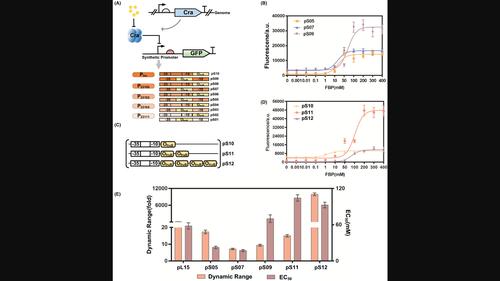当前位置:
X-MOL 学术
›
Microb. Biotechnol.
›
论文详情
Our official English website, www.x-mol.net, welcomes your
feedback! (Note: you will need to create a separate account there.)
De novo design of the global transcriptional factor Cra-regulated promoters enables highly sensitive glycolysis flux biosensor for dynamic metabolic control
Microbial Biotechnology ( IF 4.8 ) Pub Date : 2022-12-20 , DOI: 10.1111/1751-7915.14166 Yuan Zhu 1 , Huaxiao Gao 1 , Jian Zhang 1 , Jingyu Zhao 1 , Qingsheng Qi 1 , Qian Wang 1
Microbial Biotechnology ( IF 4.8 ) Pub Date : 2022-12-20 , DOI: 10.1111/1751-7915.14166 Yuan Zhu 1 , Huaxiao Gao 1 , Jian Zhang 1 , Jingyu Zhao 1 , Qingsheng Qi 1 , Qian Wang 1
Affiliation

|
Glycolytic flux is a fundamental index in microbial cell factories. A glycolytic flux biosensor that can monitor glucose metabolism efficiency is a promising strategy in rewiring metabolic flux to balance growth and biosynthesis. A key design feature of the glycolytic flux biosensors is the interaction between the global transcriptional factor Cra and its regulated promoters. However, overexpression and mutation of Cra has unpredictable effects on global metabolism in Escherichia coli. Therefore, new orthogonal biosensor design strategies should be developed to circumvent metabolic issues. In this report, the promoters in glycolytic flux biosensor were replaced with synthetic promoters of varying strengths or phage-derived promoters, and the Cra DNA-binding sites were deployed into promoters at different positions and distances to yield biosensors. The de nova biosensors that depended on Cra could sense Fructose-1,6-diphosphate (FBP) with broad dynamic ranges and low basal leakage. Then the negative-response biosensors were applied to fine-tune the target ATP synthesis gene, leading to the desired increase in pyruvate production (the highest 9.66 g/L) and cell growth. Moreover, the membrane synthesis gene plsC was also dynamically activated by the positive-response biosensor, leading to effective accumulation of lycopene in the cell membrane and a 50-fold increase in lycopene titre (100.3 mg/L) when compared with the control strain, demonstrating the effective and broader usages of our biosensors.
中文翻译:

全局转录因子 Cra 调节启动子的从头设计使高度敏感的糖酵解通量生物传感器能够用于动态代谢控制
糖酵解通量是微生物细胞工厂的一项基本指标。可以监测葡萄糖代谢效率的糖酵解通量生物传感器是重新调整代谢通量以平衡生长和生物合成的有前途的策略。糖酵解通量生物传感器的一个关键设计特征是全局转录因子 Cra 与其受调节的启动子之间的相互作用。然而,Cra 的过表达和突变对大肠杆菌的整体代谢具有不可预测的影响. 因此,应开发新的正交生物传感器设计策略来规避代谢问题。在这份报告中,糖酵解通量生物传感器中的启动子被不同强度的合成启动子或噬菌体衍生的启动子所取代,并将 Cra DNA 结合位点部署到不同位置和距离的启动子中以产生生物传感器。依赖于 Cra 的 de nova 生物传感器可以检测具有宽动态范围和低基础泄漏的 1,6-二磷酸果糖 (FBP)。然后负反应生物传感器被用于微调目标 ATP 合成基因,导致丙酮酸产量(最高 9.66 g/L)和细胞生长的预期增加。此外,膜合成基因plsC也被正反应生物传感器动态激活,导致细胞膜中番茄红素的有效积累,与对照菌株相比,番茄红素滴度 (100.3 mg/L) 增加 50 倍,证明了番茄红素的有效和更广泛的用途我们的生物传感器。
更新日期:2022-12-20
中文翻译:

全局转录因子 Cra 调节启动子的从头设计使高度敏感的糖酵解通量生物传感器能够用于动态代谢控制
糖酵解通量是微生物细胞工厂的一项基本指标。可以监测葡萄糖代谢效率的糖酵解通量生物传感器是重新调整代谢通量以平衡生长和生物合成的有前途的策略。糖酵解通量生物传感器的一个关键设计特征是全局转录因子 Cra 与其受调节的启动子之间的相互作用。然而,Cra 的过表达和突变对大肠杆菌的整体代谢具有不可预测的影响. 因此,应开发新的正交生物传感器设计策略来规避代谢问题。在这份报告中,糖酵解通量生物传感器中的启动子被不同强度的合成启动子或噬菌体衍生的启动子所取代,并将 Cra DNA 结合位点部署到不同位置和距离的启动子中以产生生物传感器。依赖于 Cra 的 de nova 生物传感器可以检测具有宽动态范围和低基础泄漏的 1,6-二磷酸果糖 (FBP)。然后负反应生物传感器被用于微调目标 ATP 合成基因,导致丙酮酸产量(最高 9.66 g/L)和细胞生长的预期增加。此外,膜合成基因plsC也被正反应生物传感器动态激活,导致细胞膜中番茄红素的有效积累,与对照菌株相比,番茄红素滴度 (100.3 mg/L) 增加 50 倍,证明了番茄红素的有效和更广泛的用途我们的生物传感器。













































 京公网安备 11010802027423号
京公网安备 11010802027423号